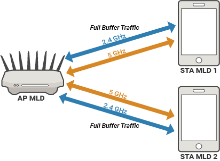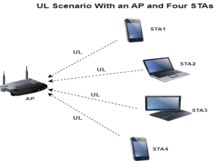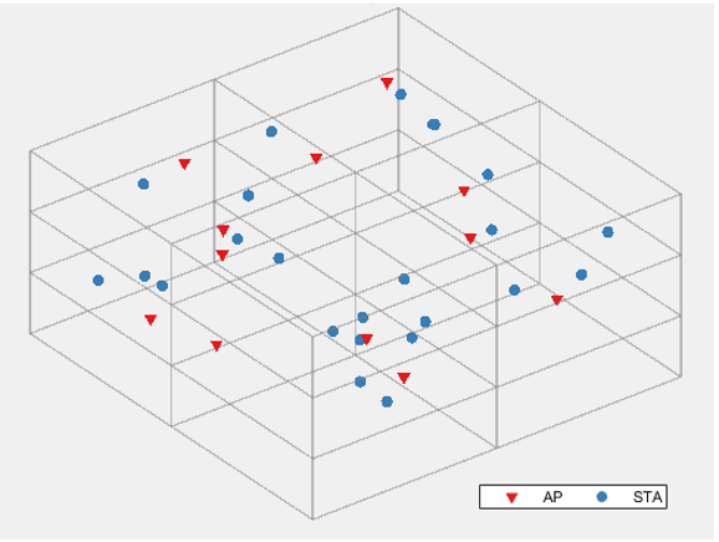System-Level Simulation
WLAN Toolbox™ system-level simulation capabilities enable you to model communication links with multiple nodes. The simulations operate across a protocol stack that includes physical (PHY), medium access control (MAC), and application layers (APP). You can measure quantities such as throughput, latency, interference, and packet loss at the node and network levels. You can also simulate and investigate the coexistence of WLAN signals with Bluetooth® signals.
The toolbox provides you with these capabilities:
Abstracted PHY or full PHY simulation
Interference modeling
Application traffic pattern modeling using file transfer protocol (FTP), On-Off, Video, and voice over internet protocol (VoIP) traffic models
Node mobility support using random waypoint mobility model
Run multiple independent simulations in parallel
IEEE® 802.11™ functionalities include:
Enhanced distributed channel access (EDCA) and quality of service (QoS)
Channel bandwidths: 20 MHz, 40 MHz, 80 MHz, 160 MHz, and 320 MHz
Frames: MAC protocol data unit (MPDU), aggregated MPDU (AMPDU), beacon, request to send (RTS), clear to send (CTS), multiuser-RTS (MU-RTS), acknowledgement (ACK), MU-block ACK request (BAR), basic trigger frame, block ACK (BA), and multi-STA BA
802.11ax™ (Wi-Fi® 6) uplink (UL) and downlink (DL) orthogonal frequency-division multiple access (OFDMA) with abstracted PHY
Overlapping basic service set packet detect (OBSS PD) based spatial reuse with BSS coloring
802.11be™ (Wi-Fi 7) simultaneous transmission and reception (STR) and enhanced multi-link single-radio (EMLSR) modes of multilink operation (MLO)
Dynamic bandwidth channel access (DBCA) support
Multiband operation: 2.4 GHz, 5 GHz, and 6 GHz
Wi-Fi mesh network, including hybrid mesh
The logging and analysis functionalities include node- and network-level statistics, visualization of node state transitions, and the logging of MAC packets into packet capture (PCAP) or PCAP next generation (PCAPNG) files.
To use the network simulation functionality with WLAN Toolbox, install the Communications Toolbox Wireless Network Simulation Library add-on.
Functions
Objects
Topics
Supported Standards
- 802.11 Standards Supported by WLAN Toolbox for System-Level Simulation
Describes the IEEE 802.11 standards supported by WLAN Toolbox for system-level simulation.
Channelization
- Valid Channel Number and Bandwidth Combinations
Describes the valid combinations of channel numbers and bandwidths for each band in system-level simulations.
What is Wi-Fi 7?
- Overview of Wi-Fi 7 (IEEE 802.11be)
Learn the concepts of IEEE 802.11be or Wi-Fi 7 standard.
Nodes and Statistics
- Composition of WLAN Nodes
Learn about WLAN node composition. - WLAN System-Level Simulation Statistics
Explore the statistics captured in a WLAN system-level simulation.
Wireless Network Simulator
- Wireless Network Simulator
Learn how the wireless network simulator object works. - Simulate 802.11ax Network With Custom TGax Channel
Simulate a 802.11ax network with a custom TGax channel. - Generate Periodic, Bursty, and Random Traffic in Wireless Network
Learn how to generate periodic and bursty traffic.
Create and Simulate 802.11 Networks
- Simulate an 802.11ax Network with Quality of Service Parameters
Configure quality of service parameters and uplink and downlink traffic in an 802.11ax network. - Create, Configure, and Simulate an 802.11ax Mesh Network
Simulate an 802.11ax mesh network and visualize the statistics. - Simulate an 802.11ax Hybrid Mesh Network
Create, configure, and simulate an 802.11ax™ hybrid mesh network. - Simulate a Multiband 802.11ax Network
Create, configure, and simulate an 802.11ax™ network operating on the 2.4 GHz and 5 GHz bands. - Simulate an 802.11ax Network with Abstracted PHY and Calculate MAC Throughput
Simulate MAC and PHY abstraction in WLAN system-level simulation.
Coexistence of Bluetooth and WLAN
- Bluetooth-WLAN Coexistence
Understand the coexistence of Bluetooth and WLAN.














